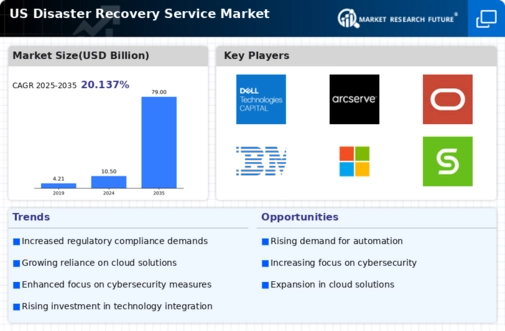Increased Regulatory Pressures
Regulatory compliance is becoming increasingly stringent, influencing the disaster recovery-service market. Organizations are required to adhere to various regulations that mandate the implementation of disaster recovery plans to protect sensitive data and ensure business continuity. For example, industries such as finance and healthcare face rigorous compliance standards that necessitate robust disaster recovery strategies. Failure to comply can result in hefty fines and legal repercussions, prompting businesses to seek specialized disaster recovery services. The market is expected to grow as companies prioritize compliance-driven recovery solutions to mitigate risks associated with regulatory failures. It is estimated that compliance-related investments in disaster recovery could increase by 25% over the next few years, reflecting the growing importance of regulatory adherence.
Shift Towards Remote Work Models
The shift towards remote work models is reshaping the landscape of the disaster recovery-service market. As organizations adapt to flexible work arrangements, the need for effective disaster recovery solutions that support remote operations has become paramount. Businesses are increasingly recognizing that traditional recovery strategies may not suffice in a remote work environment. Consequently, there is a growing demand for services that ensure data accessibility and operational continuity regardless of location. This trend is likely to drive innovation in disaster recovery solutions, as providers develop offerings tailored to remote work scenarios. The disaster recovery-service market is expected to see a surge in demand for solutions that facilitate seamless recovery processes in a distributed workforce, potentially increasing market growth by 15% in the coming years.
Rising Frequency of Natural Disasters
The increasing frequency and severity of natural disasters in the US is a significant driver for the disaster recovery-service market. Events such as hurricanes, floods, and wildfires have become more common, prompting organizations to reassess their preparedness and recovery strategies. According to the National Oceanic and Atmospheric Administration (NOAA), the US experienced over 20 weather and climate disasters in 2023 alone, each causing damages exceeding $1 billion. This alarming trend underscores the necessity for businesses to invest in disaster recovery services to protect their assets and ensure swift recovery from such events. As the threat of natural disasters continues to rise, the disaster recovery-service market is likely to expand, driven by the urgent need for effective recovery solutions.
Growing Awareness of Business Continuity
The increasing recognition of the importance of business continuity planning is a key driver in the disaster recovery-service market. Organizations are becoming more aware that disruptions can lead to significant financial losses and reputational damage. As a result, many businesses are investing in comprehensive disaster recovery strategies to ensure operational resilience. According to recent data, approximately 60% of small to medium-sized enterprises (SMEs) in the US have implemented some form of disaster recovery plan. This trend indicates a growing market for disaster recovery services, as companies seek to safeguard their operations against unforeseen events. The disaster recovery-service market is likely to benefit from this heightened awareness, as organizations prioritize continuity and recovery solutions to mitigate risks associated with potential disruptions.
Technological Advancements in Recovery Solutions
Technological innovations are driving the evolution of the disaster recovery-service market. The integration of advanced technologies such as artificial intelligence (AI), machine learning, and automation is enhancing the efficiency and effectiveness of recovery solutions. These technologies enable organizations to streamline their recovery processes, reduce downtime, and improve data integrity. For instance, AI-driven analytics can predict potential failures and automate recovery actions, thereby minimizing human intervention. The market for disaster recovery services is projected to grow as businesses increasingly adopt these advanced technologies to enhance their recovery capabilities. In fact, the adoption of AI in disaster recovery is expected to increase by over 30% in the next few years, indicating a robust demand for innovative recovery solutions.




















Leave a Comment